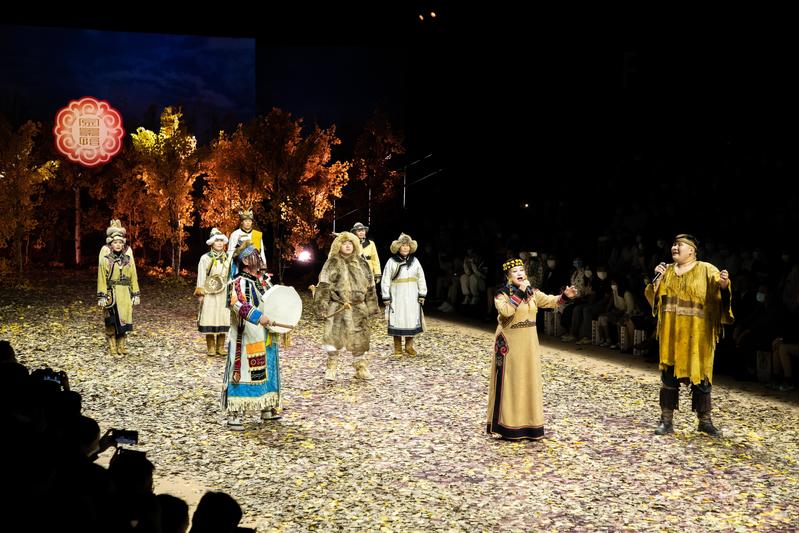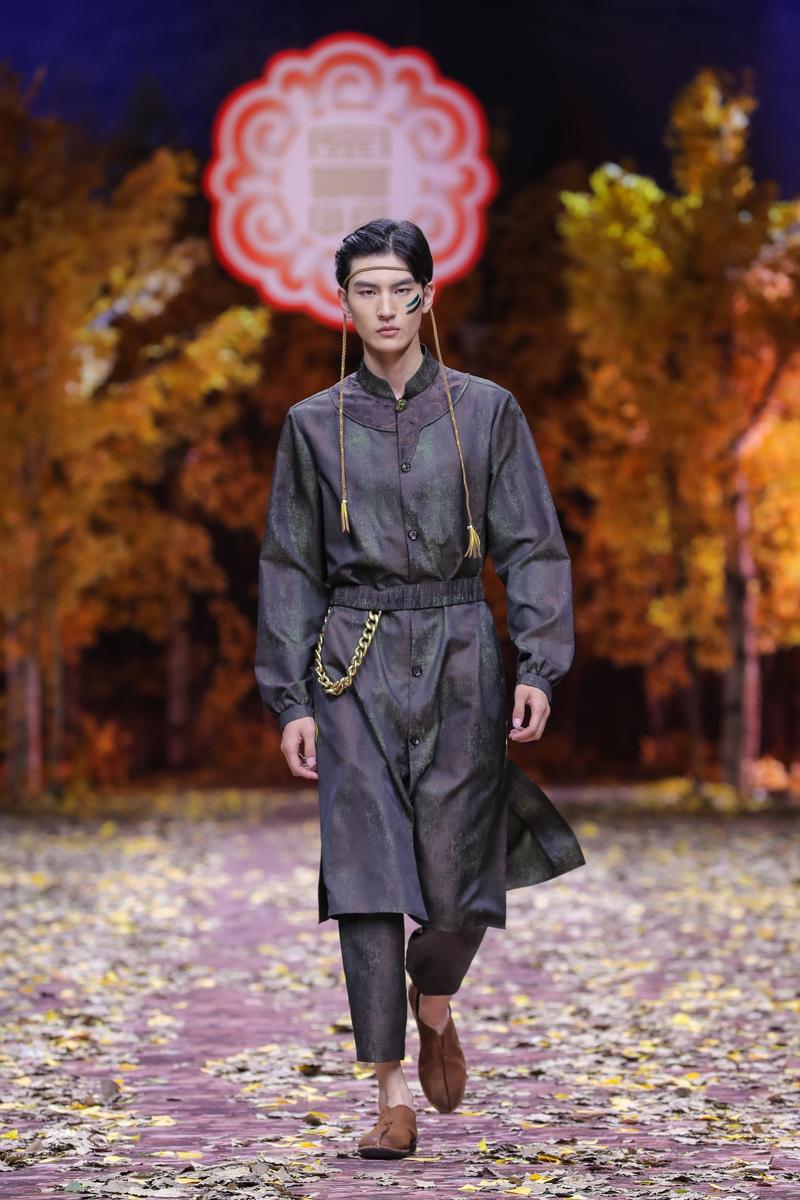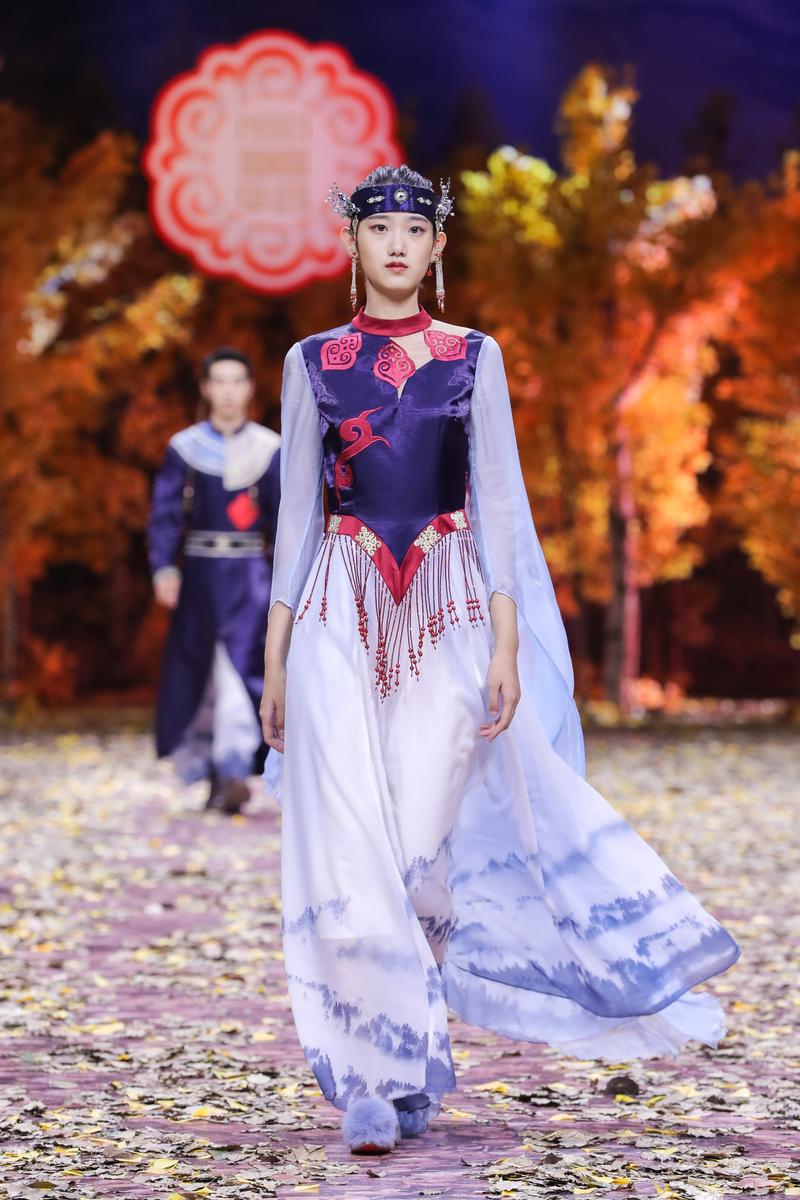Designer puts spotlight on Oroqen-style clothing at a Beijing event, Deng Zhangyu reports.
 Designer Jin Jingyi (left) adjusts a model's headwear before a show in Beijing in September. (PHOTO PROVIDED TO CHINA DAILY)
Designer Jin Jingyi (left) adjusts a model's headwear before a show in Beijing in September. (PHOTO PROVIDED TO CHINA DAILY)
Amid folk songs and drumbeats, models dressed in handmade costumes walked out of rows of silver birch trees to the runway during the China International Fashion Week in Beijing in September.
Part of the fashion week, the special show was on traditional clothing of the Oroqen ethnic group. Among the smallest communities in China, the group has a population of 8,659, according to the 2010 national census.
"It's rare for the fashion week to stage a show dedicated to an ethnic group," says Jin Jingyi, designer of the show, adding that members of the Oroqen community were invited to appear as models for its opening.
About 70 suits, combining traditional styles and modern designs were displayed, including clothes for children and the elderly.
"Rather than a fashion show, I prefer to describe it as a show that introduced the culture and stories of the Oroqen people," says the 41-year-old fashion designer.
 Models display Jin's designs for the Oroqen ethnic group during the China International Fashion Week in Beijing in September. (PHOTO PROVIDED TO CHINA DAILY)
Models display Jin's designs for the Oroqen ethnic group during the China International Fashion Week in Beijing in September. (PHOTO PROVIDED TO CHINA DAILY)
Living in the Inner Mongolia autonomous region and Heilongjiang province, the Oroqen people used to hunt for a living since most of them dwelled in forests earlier. An iconic item in their clothing is the roe deer's head hat, which was worn by hunters to attract animals.
During the annual two sessions held in March, a deputy to the National People's Congress from the Oroqen group attended a discussion wearing such a hat. The photos became an online sensation and intrigued many netizens.
"Only when people are attracted by costumes will there be a chance for them to learn more about the culture behind clothes," says Jin, who has spent years designing clothes based on styles of small ethnic groups in Northeast China.
The show in Beijing was commissioned by the local government of the Oroqen autonomous banner in Inner Mongolia, aiming to introduce their culture to a larger audience and improve people's awareness about protecting it.
 Models display Jin's designs for the Oroqen ethnic group during the China International Fashion Week in Beijing in September. (PHOTO PROVIDED TO CHINA DAILY)
Models display Jin's designs for the Oroqen ethnic group during the China International Fashion Week in Beijing in September. (PHOTO PROVIDED TO CHINA DAILY)
Jin is from the Daur ethnic group, whose members live near the Oroqen community in Inner Mongolia. The Daur group has a population of less than 140,000.
Jin spent several months this year studying Oroqen culture to design clothes that can attract as many people as possible, she says. She talked to old craftspeople who make boxes, buckets and cases with tree barks, visited local museums and had discussions with scholars.
"The difficulty of designing ethnic costumes lies in trying to find the perfect balance between traditional styles and modern fashionable designs," Jin says.
In recent years, Jin has received many orders to design ethnic costumes for daily use. She says the growing demand is partly because people have more money to spend and partly because their national pride has increased.
However, Jin says some of her customers have complained that they can't find stores to buy suitable clothes, as costumes they have access to are often out of date in regular shops.
Jin says instead of only wearing such costumes on special occasions such as festivals, many people are wearing them in daily life to showcase their identity, personality or just be different from others. "Tailored clothes for a family, from children to the old, are very popular among ethnic groups in Inner Mongolia currently."
 Models display Jin's designs for the Oroqen ethnic group during the China International Fashion Week in Beijing in September. (PHOTO PROVIDED TO CHINA DAILY)
Models display Jin's designs for the Oroqen ethnic group during the China International Fashion Week in Beijing in September. (PHOTO PROVIDED TO CHINA DAILY)
Daur culture
Jin's passion for design can be traced to her teenage years. When she was in middle school, she began to paint, especially clothes that she saw in magazines and on TV dramas. She also studied fashion design in college. Before setting up her own studio, Jin worked for a State-owned company in Beijing for 15 years. But she never gave up her design dream. She redesigned clothes for many of her colleagues and made costumes and accessories when her peers asked.
Jin was approached by other members of the Daur community. A singer once asked her to make a head accessory for a TV show. The one Jin made was praised when the singer wore it. Following that, more and more people turned to her to request accessories and costumes.
"When other people enjoyed their weekends, I was busy searching for materials in markets or making clothes by hand at home," says Jin.
She says she once received a call from an athlete asking her to design clothes for a competition. At that time, Jin had just given birth to her baby but she agreed to help the athlete from her bed.
"As a member of the Daur group, I feel it's like a duty for me. I had to make the costume for her," says Jin, who now has three children.
 Models display Jin's designs for the Oroqen ethnic group during the China International Fashion Week in Beijing in September. (PHOTO PROVIDED TO CHINA DAILY)
Models display Jin's designs for the Oroqen ethnic group during the China International Fashion Week in Beijing in September. (PHOTO PROVIDED TO CHINA DAILY)
In 2017, Jin decided to quit her job and set up her own studio because the demand for ethnic suits grew.
"People are eager to look and wear different from others nowadays. The demand for costumes also comes from those outside the ethnic groups."
There are many clothes on the market with elements based on cultures of ethnic groups, but good designs that are liked by both community members and those outside it are rare, she says.
"To make a perfect design, one has to know deep about the culture instead of staying on the surface," Jin says, adding that her identity as a Daur member helps her to better understand ethnic cultures.
Ao Yanming, a friend of Jin, says Jin has a strong sense of pride in her identity, which drives the designer to keep innovating designs.
"She is so passionate when it comes to making costumes that she can work for days with little rest and still be energetic," says Ao.
Jin says she hopes to help more small ethnic groups with fashion design.
Many elements they use in clothes are similar, such as images of animals, plants, flowers and others inspired by nature. The difference lies in how these elements are designed and made to suit the environment they live in, says Jin.
Her ambition is to design clothes based on styles of all 56 ethnic groups in China.
Contact the writer at dengzhangyu@chinadaily.com.cn


